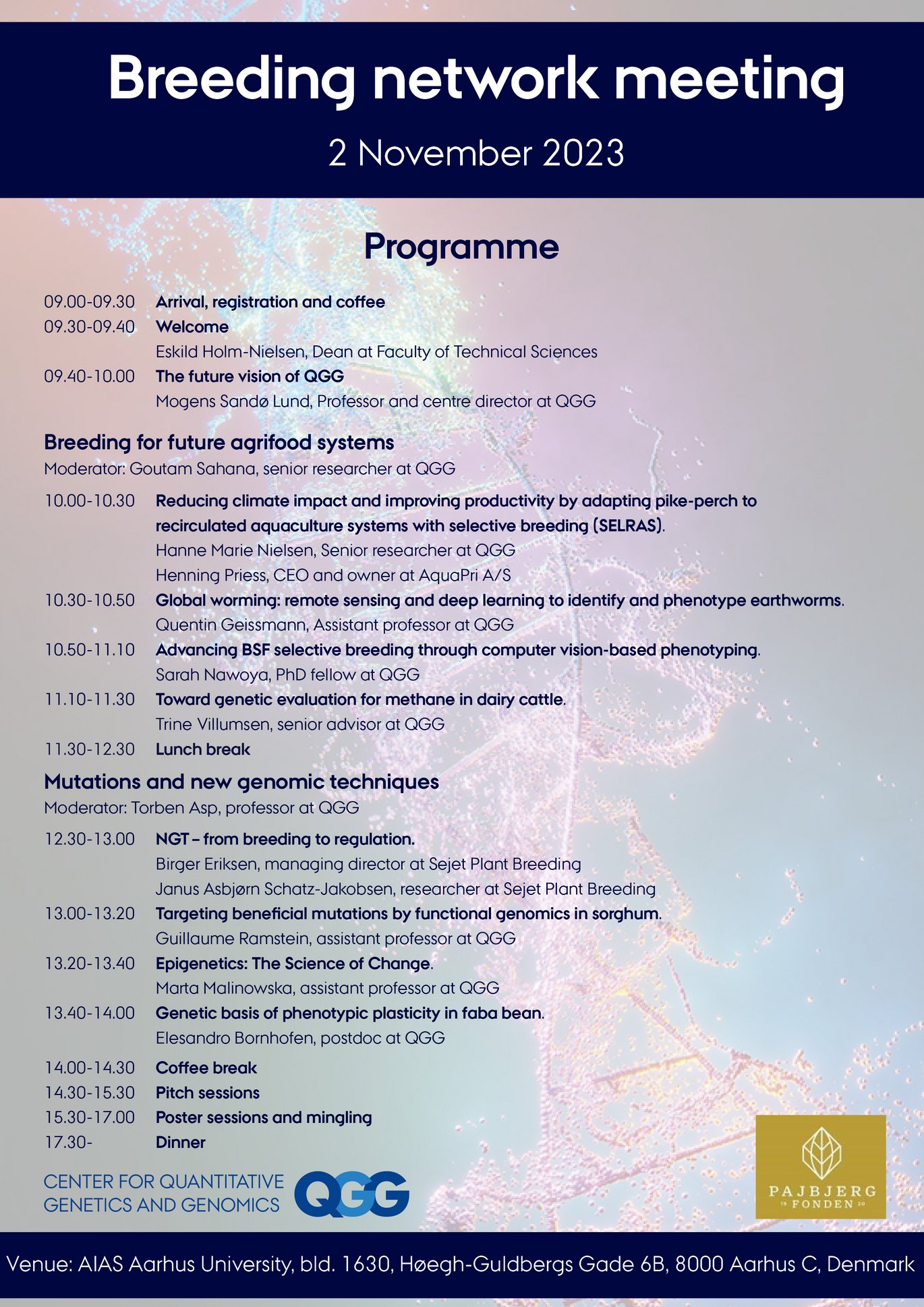Successful networking event on the agrifood industry of the future
On Thursday 2 November, the Center for Quantitative Genetics and Genomics (QGG) held the annual networking day for researchers and industry partners. The event, which was held in AIAS' premises at Aarhus University, was successful with 91 registered participants across cattle, pigs, plants, insects, and aquaculture.

The Dean of Technical Sciences at Aarhus University, Eskild Holm-Nielsen, opened the networking day by welcoming the participants. After that, centre director at QGG, professor Mogens Sandø Lund, took over and reviewed QGG's future vision.
The program was divided into two main sections, which illuminated the research field from two perspectives: Breeding for future agrifood systems and Mutations and new genomic techniques.
The first program section of the day offered a presentation on adapting pike perch to the recirculated fish farming facilities, where development is already well advanced. Today, the plants can recirculate close to 100%, and thereby significantly reduce the release of nutrients. For the pike perch, which is a relatively new aquaculture species, there is a need to make production more efficient by adapting the pike perch to these production systems through breeding.
Earthworm and black soldier fly are two other species that climate change has put on the researchers' agenda. One of the most common – and overlooked – players in agricultural soil improvement is: the earthworm! Researchers at QGG have just launched an ambitious and innovative project, where remote sensing tools and deep learning algorithms will be used to identify worms and study their behaviour underground.
The potential of soldier fly larvae as the protein source of the future and their role in a circular bioeconomy, which moreover requires so little space that small farmers in Kenya and Uganda can earn a living by rearing soldier fly larvae, are also the subject of several research projects anchored at QGG. In terms of breeding and genetics, it is challenging to phenotype soldier fly larvae as they are small and fragile. Research is therefore being carried out into using computer vision to phenotype the larvae, and the preliminary results for the use of this were presented at the network meeting.
The first section’s last presentation on breeding for future agricultural and food industry offered an introduction to how breeding can contribute to reducing methane emissions from cattle. Methane emissions from agriculture are a significant source of greenhouse gases, and intense research is being done into how emissions can be reduced. In QGG, a database is built with methane records from individual cows, and this data is used to develop genetic models, which will make it possible in the future to assess breeding value and select dairy cows for methane production.
The second section of the programme dealt with mutations and new genomic techniques in the plant field.
SEJET Plant Breeding presented the history of legislation in the use of new genomic plant breeding techniques as well as the perspectives in the use of these methods in plant breeding. The designation covers several plant breeding techniques that are relatively new, and which we do not yet know how to regulate legally.
The presentation was followed by a study of Sorghum, where the use of functional genomics is used to detect beneficial mutations that can be used in future breeding. Today's crops are far from the wild species from which they originated. Domestication and improvement of plants is due to beneficial mutations – ie. permanent changes in the plants' DNA. The crops we grow in the fields today are the result of a long domestication process that can be shortened and targeted using functional genomics.
The ability of epigenetics to regulate a plant's genes is important for understanding of how plants adapt to the surrounding environment. Epigenetics can have a significant role in the development of more efficient and robust crops with a smaller climate and environmental footprint. One of the epigenetic mechanisms is DNA methylation, and the importance of DNA methylation in plant breeding was presented at the meeting.
Faba beans are another species in the plant area, where research is developing fast these years, and that was what the last presentation of the day was about. Researchers at AU have recently succeeded in mapping the faba bean genome, and this has wide prospects for plant-based protein sources of the future, including in animal feed, where sustainable, Danish-produced faba beans can replace some of the soy protein that is imported from, among other places, South America.
The programme ended with a pitch and poster session, where 17 different posters were presented concerning research within livestock breeding, plant breeding and genetics with a focus on genetic improvement and progress, genomic selection, inbreeding and environment-genetic interactions. Within these topics, the latest research within tissue-specific gene expression, image-based phenotyping, deep learning methods for biodiversity monitoring was also presented.
